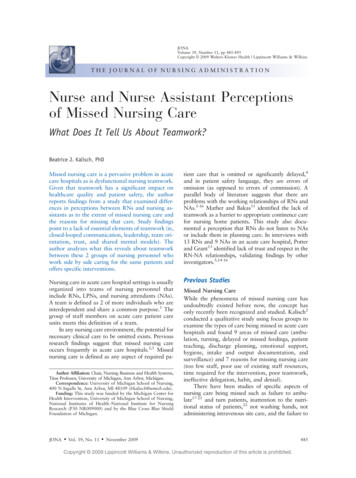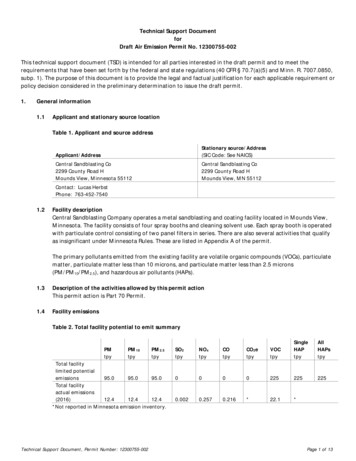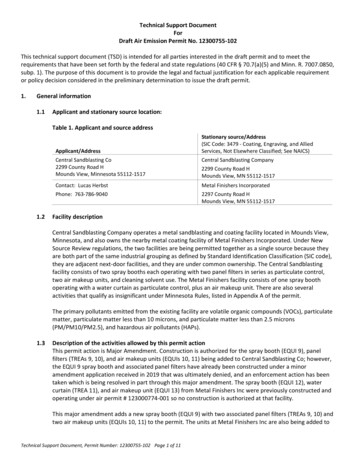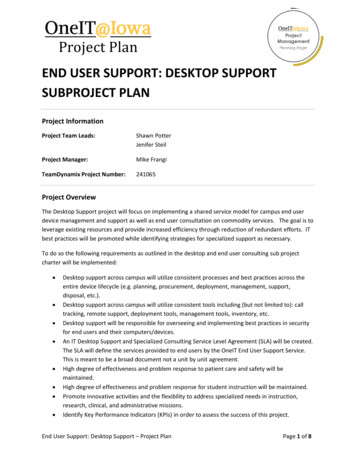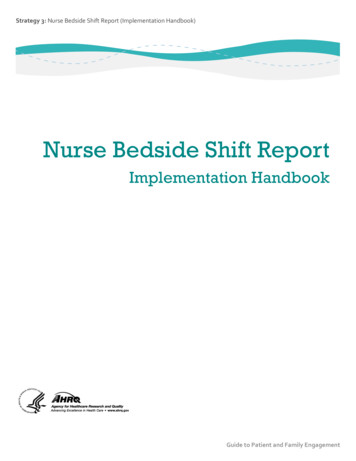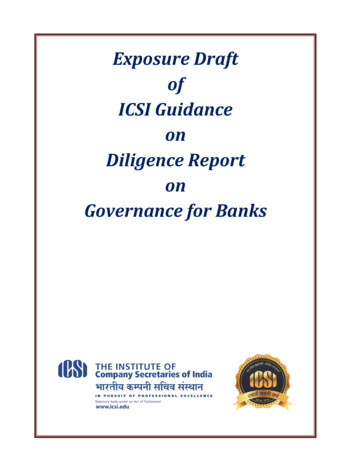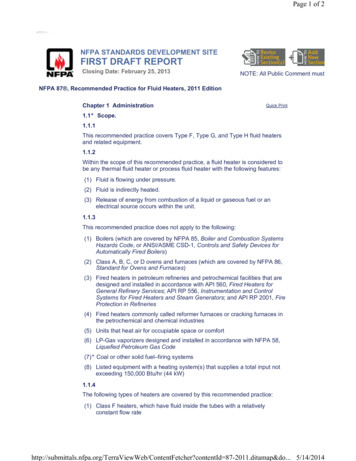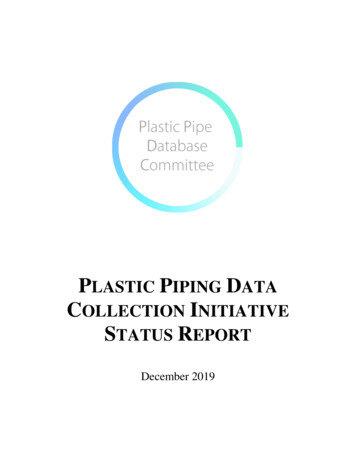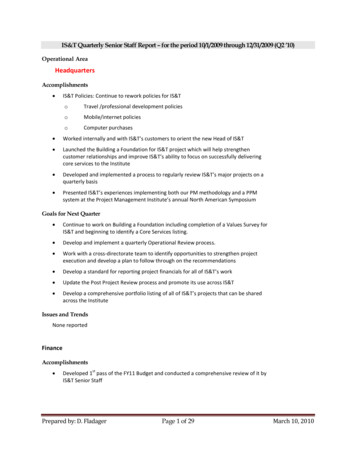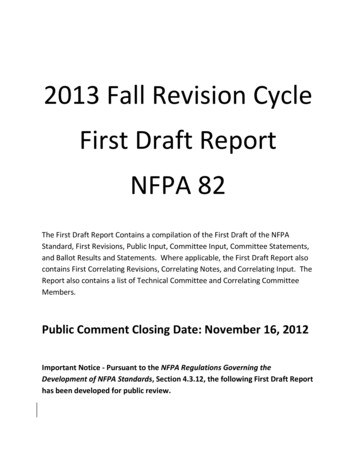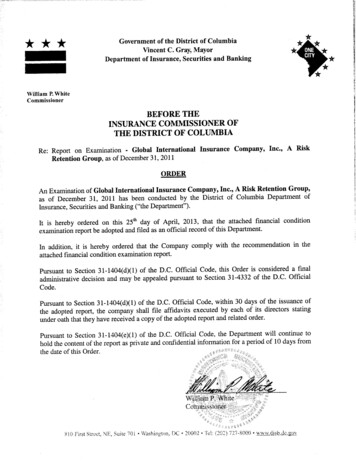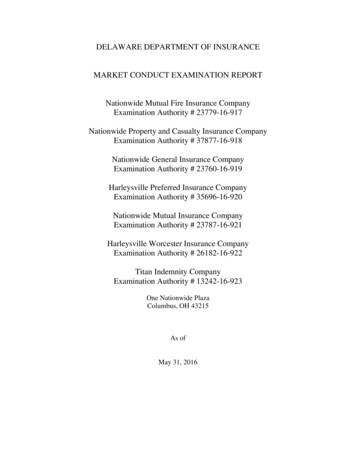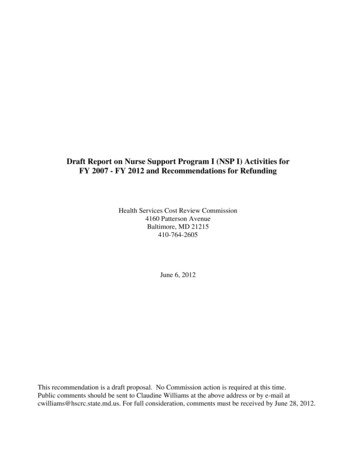
Transcription
Draft Report on Nurse Support Program I (NSP I) Activities forFY 2007 - FY 2012 and Recommendations for RefundingHealth Services Cost Review Commission4160 Patterson AvenueBaltimore, MD 21215410-764-2605June 6, 2012This recommendation is a draft proposal. No Commission action is required at this time.Public comments should be sent to Claudine Williams at the above address or by e-mail atcwilliams@hscrc.state.md.us. For full consideration, comments must be received by June 28, 2012.
Draft Report on Nurse Support Program I (NSP I) Activities for FY 2007 - FY 2012 andRecommendations for RefundingJune 6, 2012PurposeThis recommendation summarizes the activities of the Nurse Support Program I during the last 5year cycle (FY 2007-FY 2012), and recommends renewal of the program for another 5 year cyclewith modifications.BackgroundIn 1986, the HSCRC initiated nurse education support through the collaborative efforts of hospitals,payers, and nursing representatives in response to a growing nursing shortage in Maryland.Originally, the Nurse Education Support Program (NESP) focused on supporting college andhospital-based training of Registered Nurses (RNs) and Licensed Practical Nurses (LPNs). Over theyears, the NESP expanded to encourage new and innovative approaches to address the challengesand demands facing the nursing profession and allied professions. HSCRC allocated approximately 7 million in hospital rates to thirty-seven hospitals that participated in the NESP from 1986through 1995 when the program concluded.As the economic situation in the US improved during the late 1990s-early 2000, another nursingshortage emerged. In 200l, the U.S. General Accounting Office conducted a study regarding thestate of the nursing workforce in response to a congressional inquiry.1 Results indicated thatalthough national data were not adequate to describe the nature and extent of the potential nurseshortage, there was compelling evidence (declines in the RN unemployment rate and the RNs percapita) that suggests that the nursing shortage was a real phenomenon and that it would continue togrow. According to data from the National Sample Survey of Registered Nurses, there was a 2percent decline nationally in the number of employed nurses per 100,000 people between 1996 and2000. The study also listed multiple obstacles to increasing the supply of nurses including, an agingworkforce, declines in younger nurses entering the field, a general dissatisfaction with the nursingenvironment (particularly staffing levels), concerns with quality of patient care, and lack ofadministrative support.Although there was a slight (1.7 percent) increase in the number of employed RNs for the sametime period in Maryland, the nursing workforce was experiencing similar dissatisfaction, accordingto a survey conducted by the Maryland Commission on the Crisis in Nursing in 2001.2 In an effortto sustain and improve the number of bedside nurses in Maryland, the HSCRC initiated a new five–year, hospital-based, non-competitive grant program in 2000. The primary focus of Nurse SupportProgram I (NSP I) was increasing the number of bedside nurses in Maryland through retention andrecruitment initiatives. Hospitals submitted proposals to the HSCRC for three- to five-year projectsthat ranged from nursing educational scholarships for their employees to high school outreach. Amulti-stakeholder Evaluation Committee, comprised of nurse experts, reviewed the proposals andmade recommendations to the Commission for funding. Funding was distributed through anincrease in each hospital’s rates equal to 0.1 percent of their regulated gross patient revenue fromthe prior year. Almost all Maryland acute care hospitals participated in NSP I from 2001-2006,receiving almost 36 million in rates.1United States General Accounting Office, Nursing Workforce: Emerging Nurse Shortages Due to Multiple Factors (GAO-01-944, July2001)Workplace Survey 2001. Maryland Commission on the Crisis in Nursing. Maryland Board of Nursing, Workplace Issues Subcommittee.22
Draft Report on Nurse Support Program I (NSP I) Activities for FY 2007 - FY 2012 andRecommendations for RefundingJune 6, 20122007 Evaluation and Recommendation to the CommissionIn 2005, HSCRC staff conducted an evaluation of the NSP I program, in part, because of difficultiesin demonstrating program outcomes and accountability, unclear guidelines for eligible programactivities, and a need to define the scope of the NSP I considering the initiation of the NSP IIprogram in FY 2006. The Commission established the following NSP I evaluation goals: Clarify the categories of programs eligible for funding Fund projects deemed most valuable by nursing experts Simplify the application and reporting process, and Increase accountability through standardized program outcome and financial reportingWith the assistance of hospital industry, NSP I coordinators, nurse executives and educators, theBoard of Nursing, and HSCRC leadership, HSCRC re-evaluated the NSP I program. HSCRC staffalso contracted with a nurse researcher with nationally recognized expertise on the nursing shortageto provide consultation in program review and evaluation, and assistance with development of astandardized, objective reporting format. Upon completion of the evaluation, HSCRC staffrecommended to the Commission the following modifications to the NSP I program:1. Redefine categories of initiatives eligible for funding and establish categories that areineligible for funding2. Revise the Request for Applications process for grant funding to a simplified applicationprocess3. Revise the review and evaluation process for initiative approvals and renewals4. Ongoing review of the funding mechanism; and5. Standardize quantitative annual reports to include uniform financial and annual datareporting requirementsThe Commission approved program modifications and renewed funding for another five-year cyclefrom FY 2008 to FY 2012.Implementation of Modified NSP I ProgramApplication ProcessIn the spring of 2007, hospitals submitted proposals in response to an HSCRC-issued Request forApplications (RFAs) that incorporated areas recommended by nurse experts as being most valuablein improving nurse retention and the supply of bedside nurses. HSCRC staff encouraged hospitals topropose programs that included one or more of the following broad categories: Educational Attainment: This category includes all initiatives involving improvededucational qualifications for nurses (RNs and LPNs) as well as initiatives to producemore nurses. Examples include: tuition, stipends, or release time for pursuit of additionaleducation or qualification; software and hardware specifically dedicated for use innursing education would be considered on an individual basis.3
Draft Report on Nurse Support Program I (NSP I) Activities for FY 2007 - FY 2012 andRecommendations for RefundingJune 6, 2012 Nurse Retention and Recruitment: This category applies to all initiatives involvingretention of nurses. Examples include: mentoring, internships, residencies, and othersupport for new graduates and new hires, as well as, all initiatives involving recruitmentincluding nurse shadowing programs, externships, and summer employment forprospective nursing students. Improved Nurse Practice Environment: This category applies to all initiatives toimprove nurse practice environment including working on or achieving Magnet Status,joint governance, and other initiatives to improve nurse practice environment.For those healthcare organizations that did not plan to work toward achieving MagnetStatus, projects related to the components of Magnet Status, or “Forces of Magnetism,”such as implementation of professional standards of nursing practice, a nursing qualityindicator program, or applied nursing research. Other examples include: programs todevelop new approaches to staffing, scheduling, and allocation of patient care resources. Other Creative Initiatives Proposals to increase the number of bedside nurses will beconsidered provided that the goals and objectives are clearly defined, evaluation metricsare identified, and budget requests fall within the defined NSP I parameters. Theseinitiatives might include projects that require outside expertise that could be shared, suchas the Project LINC and the Nurse Managers Leadership Institute, previously funded inpart by NSP I.An independent NSP I Evaluation Committee, comprised of representatives from HSCRC staff,hospital nursing leadership, payers, nursing recruiters, the Maryland Hospital Association, theMaryland Higher Education Commission, and human resources professionals reviewed theapplications that met the minimum requirements outlined in the application form. The EvaluationCommittee recommended 43 hospitals for funding for FY 2008, and the Commission approved therecommendation.Revisions to the Annual ReportsHSCRC required hospitals to submit a standardized annual report and budget form at the end ofeach fiscal year. HSCRC staff expanded the annual report to include metrics that addressed thevaried programs the hospitals proposed. HSCRC staff also developed a standardized budget form toassist in tracking how hospitals expended NSP I funds. HSCRC staff required hospitals to submit aproposed budget form at the beginning of the fiscal year. At the end of the fiscal year, hospitalsreported their actual expenditures. HSCRC staff reduced the following year's budget request by theamount of the unspent funds in the prior year.4
Draft Report on Nurse Support Program I (NSP I) Activities for FY 2007 - FY 2012 andRecommendations for RefundingJune 6, 2012NSP I AchievementsThe primary goal of the NSP I Program is to increase the number of bedside nurses in Marylandthrough retention and recruitment. Over the last 5 years, Maryland hospitals have met and exceededthis goal. The funding provided by NSP I has enabled hospitals to promote, nursing throughenhanced educational opportunities, leadership development, research and joint governance.Hospitals indicate that these efforts have translated into higher satisfaction among Maryland nursesand better outcomes for patients.Increased the Number of Bedside NursesIn recent years, there has been a resurgence of nurses in the workforce. According to the HSCRCWage and Salary Survey, Maryland hospitals increased the number of nurses by 15 percent between2007 and 2011 (Chart 1). Eleven hospitals increased their nursing staff by more than 25 percent.There are several factors that may contribute to the increase in nursing workforce, including thestate of the economy; nurses who would have otherwise retired are staying in their jobs orincreasing their hours.3 However, studies are predicting that this trend is temporary. The increasingdemand for nurses to care for an aging nation, coupled with reduction in the workforce as nursesretire, will create an “unprecedented shortage of RN’s in the United States.”4Chart 13P. I. Buerhaus. Current and Future State of the US Nursing Workforce. Journal of the American Medical Association. 300:20 (2008).D.I. Auerbachm, P.I. Buerhaus & D.O. Staiger. Registered Nurse Supply Grows Faster Than Projected Amid Surge In New Entrants: Ages 23 -26.Health Affairs, 30, no.12 (2011):2286-2292; B.L.Cleary, A.B. McBride, M.L.McClure, & S.C. Reinhard. Expanding The Capacity Of Nursing .Health Affairs, 28, no.4 (2009):w634-w64545
Draft Report on Nurse Support Program I (NSP I) Activities for FY 2007 - FY 2012 andRecommendations for RefundingJune 6, 2012Hospitals attribute another reason for the increase in their nurse workforce to initiatives funded bythe NSP I program. NSP I funding has enabled hospitals to develop programs aimed towardattracting and retaining new nursing graduates through rigorous residency and orientation programs,promoting nursing education for clinical and non-clinical staff, and providing extern and internopportunities for nursing students who are subsequently hired as staff. For example, Johns HopkinsHospital’s Social and Professional Reality Integration for Nurse Graduates (SPRING) programfocused on the retention of new graduate nurses in adult inpatient and critical care departmentsthrough a year-long internship. Through this program, Hopkins has been able to maintain anaverage retention rate of 88 percent among new graduates over the last 5 years. Franklin SquareHospital Center, through established partnerships with the weekend nursing program at CommunityCollege of Baltimore County (CCBC), increased the number of bedside RNs by offering tuitionassistance to 30 non-clinical staff. With NSP I funding, Upper Chesapeake Medical Center (UCMC)sponsored an externship program where 90 percent of the students in the program have accepted RNpositions at UCMC or at Harford Memorial Hospital. The externship program at Union MemorialHospital (UMH) has produced 78 bedside nurses since FY2007; 59 of these nurses are currentlyemployed at UMH.Reduced Dependency on Agency NursesAccording to the HSCRC Wage and Salary survey, Maryland hospitals decreased their dependenceon agency nurses by 68 percent, saving more than 98 million in agency costs between FY 2007and FY 2011 (Chart 2). NSP I coordinators cite improved retention of existing nurses as the reasonfor the decreased usage of agency nurses.68% reductionSavings: 98 M inAgency CostsChart 26
Draft Report on Nurse Support Program I (NSP I) Activities for FY 2007 - FY 2012 andRecommendations for RefundingJune 6, 2012Increased the Number of Certified and Advanced Degree NursesA number of studies have shown a link between higher nursing education and better patientoutcomes. One study showed compelling evidence that a 10 percent increase in the number of BSNdegree nurses decreased the risk of patient death and failure to rescue by 5 percent.5 In an effort toimprove the level of education of their nursing staff, Maryland hospitals spent approximately 8.5million on scholarships and tuition reimbursement for nursing education through the NSP I programbetween 2008 and 2011. Hospitals provide a majority of these funds (64 percent) for scholarshipsand tuition reimbursement for their nursing staff. Although, the number of hospitals reportingtuition assistance between FY 2008 and FY 2011 dropped from 25 hospitals to 19, investment intheir staff’s education more than doubled between FY 2008 and FY 2011, from 790,000 to 1.6million respectively, peaking in FY2010 at 2.2 million. Maryland hospitals also invested close to 3 million in local nursing students through scholarships. In return, the students have serviceobligations at the hospital for a specific period of time ranging from 2 to 5 years. Between FY 2008and FY2010, hospitals provided support to program participants pursuing the following degrees: 488 LPN or Associate degrees in Nursing 782 BSN degrees 95 MSN degreesMaryland hospitals have also encouraged nursing staff to improve their competencies throughprofessional certifications. Approximately 2,800 nurses completed certifications in various areasincluding, emergency room, pain management, wound care, medical-surgical and neonatal, throughthe NSP I initiatives between 2008 and 2011. St. Joseph Hospital used NSP I funds to improve thepercentage of nurses with professional certifications. In FY 2011, the number of nurses withprofessional certifications at St. Joseph Hospital increased from 7 percent to 22 percent. Mercy hasalso seen a dramatic increase the number of certified nurses, from 22 in FY 2007 to 146 in FY 2011,an 85 percent increase.Reduced Nurse Vacancy and Turnover RatesAlthough a direct link cannot be made between the NSP I programs and vacancy or turnover rates,statewide data show significant reductions in vacancy rates for RNs and LPNs (26 percent and 57percent, respectively) during this NSP I cycle (Chart 3). There also seems to be a similar downwardtrend for turnover rates (Chart 4). LPN turnover and vacancy rates have risen in the last 3 years,possibly because of the increased push for LPNs to become RNs as opportunities for LPNs inhospitals have declined.5L. H. Aiken, S.P. Clarke, R.B. Cheung, D. M. Sloane, & J.H. Silber. Educational Levels of Hospital Nurses and Surgical Patient Mortality. Journalof the American Medical Association. 290:12 (2003). 1617-16237
Draft Report on Nurse Support Program I (NSP I) Activities for FY 2007 - FY 2012 andRecommendations for RefundingJune 6, 201226% reduction for LPNs57% reduction for RNs9% reduction for LPNs22% reduction for RNsChart 3Chart 4NSP I coordinators attribute the reduction in turnover and vacancy rates to improved nursingsatisfaction. The funding provided by NSP I has enabled hospitals to promote nursing throughenhanced educational opportunities, leadership development, research and joint governance. Duringthe last 5 years, hospitals have established processes to encourage leadership development in avariety of areas. Some hospitals, like Bon Secours, have difficulty recruiting and retaining nursesbecause of their size or patient mix. Bon Secours invested its NSP I funds in developing aninfrastructure for professional practice and engagement. The nursing leadership instituted councilsthat focus on three areas: professional development and improving the practice of nursing;recruitment, retention and recognition of nurses; and the lead partner’s council. These councilsprovide nurses with a forum to communicate and collaborate with other departments. Through theseefforts, Bon Secours have been able to reduce its voluntary turnover rate from 14 percent to 8percent.Recognized as Leaders in Nursing ExcellenceThe Magnet Recognition program recognizes healthcare organizations for quality patient care,nursing excellence, and innovation in professional nursing practice. During the last 5 years, 6hospitals have received Magnet designation by the American Nurses Credentialing Center. Thesehospitals, and when they gained Magnet status, are listed below: Franklin Square Hospital Center (2008) University of Maryland Medical Center (2009) Memorial Hospital of Easton (2009) Dorchester General Hospital (2009) Sinai Hospital (2009) Mercy Medical Center (2011)8
Draft Report on Nurse Support Program I (NSP I) Activities for FY 2007 - FY 2012 andRecommendations for RefundingJune 6, 2012With funding from the NSP I program, 11 more Maryland hospitals are on course to Magnet status.Hospital quality data collected by the HSCRC have shown a link between Magnet hospitals andimproved patient care, safety, and satisfaction. For FY2011, Maryland Magnet hospitals hadlower rates of nursing-sensitive Maryland hospital acquired complications (MHACs) than nonMagnet Maryland hospitals.Nursing Sensitive Hospital-Acquired Complications, FY 2011Risk Adjusted Complication Rates per 1,000 admissionSource: 3M Potentially Preventable Complications (PPC) Grouper using HSCRC FY2011 Abstract DataMHAC e1.111.54-27.92%0.060.21-71.43%PPC 31:Decibutus UlcerPPC 28:In-Hospital Trauma and Fractures**Statistically SignificantOn the Hospital Care Quality Information from the Consumer Perspective (HCAHPC), for CY2010, Maryland Magnet hospitals tended to score higher on indicators of patient satisfaction thannon- Magnet hospitals.Patient Experience of Care Measures, CY 2010Source: HCAHPSMagnetHospitalsHCAHPS MeasureNon-MagnetHospitalsDifferenceCommunication About Medicines (Q16-Q17)*63.4%57.0%6.45%Communication With Nurses (Q1-Q3)80.4%75.8%4.60%Discharge Information (Q19-Q20)*86.2%80.9%5.35%Responsiveness of Hospital Staff (Q4,Q11)*63.2%56.7%6.54%Communication With Doctors (Q5-Q7)80.8%77.8%3.00%Pain Management (Q13-Q14)70.2%67.1%3.05%Cleanliness of Hospital Environment65.6%64.1%1.50%Quietness of Hospital Environment54.2%53.7%0.52%Willingness to Recommend this Hospital72.2%66.0%6.25%Overall Rating of this Hospital70.8%64.7%6.14%HCAHPS score in QBR for FY2012 Rates*65.4%37.1%28.30%*Statistically
Jun 06, 2012 · College of Baltimore County (CCBC), increased the number of bedside RNs by offering tuition assistance to 30 non-clinical staff. With NSP I funding, Upper Chesapeake Medical Center (UCMC) sponsored an externship program where 90 percent of the students in the program have accepted RN
